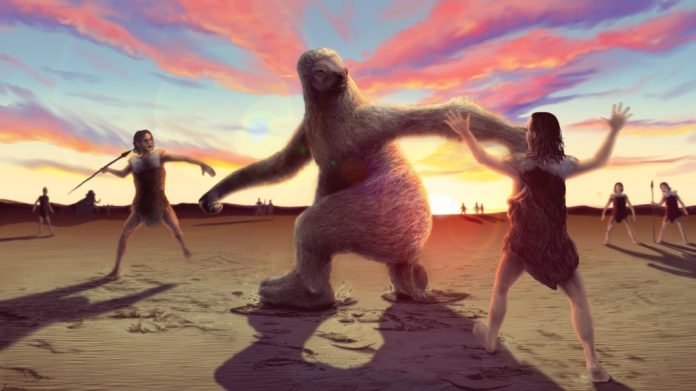
A newly discovered fossil shows that about 11,000 years ago, giant 7-feet tall (2.1 meters) sloths roamed the earth while being stalked by ancient humans regardless of where the creatures went. Theories are based on humans being decided to wipe out the animal. In fact, it is fossils that prove that humans engaged in deadly face-offs with the gigantic sloths.
Found in the white sands of New Mexico, this newly found fossil revealed not only how humans stalked the 7-feet tall ancestral sloths, due to human footprints found inside the fossilized sloth print, but also that these animals roamed North America over a period of time. Researchers from Bournemouth University have revealed that many stories can be found in the footprints.
An incredible set of tracks—human footprints nested *inside* those of a ground sloth—tell the story of a prehistoric hunt, @edyong209 reports: https://t.co/SDoVh89PNP
— The Atlantic (@TheAtlantic) April 26, 2018
Men used to stalk and hunt sloths for reasons unknown
As these found footprints show, humans used to stalk sloths by literally following the animal’s steps, as shown in the sloth’s print. This stalking would eventually take to many humans working as a team by distracting the animal so another one could deliver the killer blow, this is all deducted from the fossilized prints, and it is the first time science has found how ancient humans tackled their preys.
Professor Matthew Bennett from Bournemouth University stated that it is a fact that humans tackled these animals by working together, as there are two sets of human footprints following the sloth’s exact steps. There is also evidence that this activity could even have been a routine for the men of the time, as the multiple tracks show an actual behavior around the sloth.
Any interest in 10,000 year-old battles between hunters and the hunted (plus… then-dangerous Giant Sloths)? https://t.co/VKaYVPnNoE pic.twitter.com/5UjwdmyfQB
— Ars Technica (@arstechnica) April 26, 2018
Regardless of being basically an herbivore creature, it is no surprise that our ancestors would find these gigantic creatures a threat, this is the most likely reason that led humans to über hunt sloths.
According to Bennett chances of facing a sloth of the time were basically critical for men, with Wolverine-like claws that can turn out to be “7 or 8 feet tall when reared up on its hind legs” plus the fact that giant sloths were surprisingly faster than actual small lovable creatures, due to digestion issues, actually engrave the situation for the men that would engage the possible fierce beast.
Bennett confirmed that a lot can be found in these prehistorical tracks as they can show us “behavioral ecology”, which happens to be very rare and to further explore this well-preserved tracks, the UK based researchers have been employing forensic technology used by criminologists.
Source: Science Advances











